Design and Technology > AS Mark Scheme > GCE Design and Technology H406/02: Problem solving in Product Design Advanced GCE Mark Scheme for Au (All)
GCE Design and Technology H406/02: Problem solving in Product Design Advanced GCE Mark Scheme for Autumn 2021
Document Content and Description Below
Oxford Cambridge and RSA Examinations GCE Design and Technology H406/02: Problem solving in Product Design Advanced GCE Mark Scheme for Autumn 2021Oxford Cambridge and RSA Examinations OCR (Oxfo... rd Cambridge and RSA) is a leading UK awarding body, providing a wide range of qualifications to meet the needs of candidates of all ages and abilities. OCR qualifications include AS/A Levels, Diplomas, GCSEs, Cambridge Nationals, Cambridge Technicals, Functional Skills, Key Skills, Entry Level qualifications, NVQs and vocational qualifications in areas such as IT, business, languages, teaching/training, administration and secretarial skills. It is also responsible for developing new specifications to meet national requirements and the needs of students and teachers. OCR is a not-for-profit organisation; any surplus made is invested back into the establishment to help towards the development of qualifications and support, which keep pace with the changing needs of today’s society. This mark scheme is published as an aid to teachers and students, to indicate the requirements of the examination. It shows the basis on which marks were awarded by examiners. It does not indicate the details of the discussions which took place at an examiners’ meeting before marking commenced. All examiners are instructed that alternative correct answers and unexpected approaches in candidates’ scripts must be given marks that fairly reflect the relevant knowledge and skills demonstrated. Mark schemes should be read in conjunction with the published question papers and the report on the examination. © OCR 2021H406/02 Mark Scheme October 2021 Question Answer Mark Guidance 1 Indicative content: Roof: Examples: Slate: • likely to be old or broken roofing slates. • readily available. • easy to work to shape. Challenges: • broken. • irregular shapes and thicknesses. • damage from water ingress. • fungal growth needs cleaning. Tubes: Examples: Joinery soft/hardwood off-cuts: • Readily available from existing joinery businesses. • Make good use of existing waste material. • Range of materials and forms/sections available. • Anti-parasitic qualities of some woods. Challenges: • Off-cuts may vary in section and length. • Supply to meet the manufacturing demand could be an issue. Bamboo: • Readily available in native form. Challenges: • Less likely to be available for upcycling. Old bamboo tends to deteriorate. • Very cheap to buy new, rarely seen for sale used. Main body: Examples: Pallet wood: • On trend. • Readily available. • Easy to work to an acceptable stock form for manufacture by using planer/thicknesser. Challenges: • Poor quality wood. 8 All responses should be in relation to the upcycled materials shown. Answers should include consideration of appropriate materials, availability and suitability for the batch of 50 insect hotels. Challenges should be identified. Candidates may extract information from the Resource Booklet. Any such lifted information can be used in support of the critical evaluation but no marks should be awarded simply for duplicating text. There is no analysis or evaluation in Level 1. Level 4 [7-8 marks] A comprehensive examination of the challenges that will be faced. Comprehensive understanding of the challenges that will be faced when making the insect hotels from upcycled materials. Materials analysis is consistently and appropriately aligned with the context provided. Information in RB is used effectively to fully exemplify the points being made. Well-constructed response in relation to question with a clear and developed narrative. There is a well-developed line of reasoning which is clear and logically structured. The information presented is relevant and substantiated. Level 3 [5-6 marks] A good examination of the challenges that will be faced. Good level of understanding of the challenges that will be faced when making the insect hotels from upcycled materials. Materials analysis is appropriately aligned with context but one or two opportunities are missed to make connections. Information in RB is used for the most part effectively to exemplify points being made although one or two opportunities are missed. Wellconstructed response in relation to question although one or two opportunities missed to develop narrative. There is a line of reasoning presented with some structure. The information presented is in the most part relevant and supported by some evidence.H406/02 Mark Scheme October 2021 • Splits, knots. • Damage from nails / staples. • Nails could cause tool/machine damage. • Possible chemically treated. Could be toxic to garden creatures e.g. methyl bromide treatment: this is a pesticide fumigation used to kill insects. Award credit for any other valid suggestion. Level 2 [3-4 marks] A sufficient examination of the challenges that will be faced. Sufficient understanding of the challenges that will be faced when making the insect hotels from upcycled materials. Materials analysis is reasonably aligned with context but there are significant opportunities missed to make connections. Information in RB is used to exemplify some points being made although much more could have been done to exploit the stimulus material available. Reasonable response in relation to the question although narrative at times lacks depth and cohesion. The information has some relevance and is presented with limited structure. The information is supported by limited evidence. Level 1 [1-2 marks] A limited examination of the challenges that will be faced. Limited knowledge and next to no understanding of the challenges that will be faced when making the insect hotels from upcycled materials. Isolated statements made in relation to materials resulting in only weak alignment with context. Use of information from the RB is used in a simplistic way and adds limited value to the points being made. Limited response in relation to question. Narrative is basic and unstructured. The information is basic and communicated in an unstructured way. The information is supportedH406/02 Mark Scheme October 2021 by limited evidence and the relationship to the evidence may not be clear. 0 marks = No response or no response worthy of credit.H406/02 Mark Scheme October 2021 2 Indicative content: Preparation of surfaces to ensure a quality outcome: • Use of a planer/thicknesser to cut back rough wood to a smooth finish. • Sanding may be necessary to remove existing surface finishes. • Glass paper, garnet paper and wire wool may be used to prepare the surface for painting. • Use a tack cloth or damp cloth (water) to wipe away residual dust before painting. • Existing surface finishes or chemical treatments / stains /paints may react with new surface finish. • Pallet wood (sofa wood) is very porous and a primer may be necessary to help seal the wood before application of the top coats of paint. Prevention of decay: • Using a primer, painting and then sealing the birdhouse will offer the most comprehensive protection against the elements. • Some pallet wood is already preserved. • A water repellent can be applied to the wood before priming/painting. It is important for end grain to soak up the water repellent either through soaking or pressure treatment. • A primer with titanium dioxide and styrene resin is suitable for outdoor use and will help the birdhouse resist mould while also preventing paint peeling. • A clear, UV absorbent, protectant can be applied last to protect the wood and painted surface finish. Prevention of harm to wildlife: • Water-based, low volatile organic compound (VOC), non-toxic sealer / primer / paint should be used to prevent harm to birds and other animals, and minimise fumes in painting. Any necessary risk assessments: Thicknessing/planing: • Wear eye protection. Tie back long hair, remove or cover jewellery and cover loose clothing with a secure apron or overall. • Wear ear defenders when high noise levels could create problems. • Fit an anti-kickback device over the whole working width of machines used for thicknessing. If a kickback device is not available then only one piece of timber should be fed into the machine at a time. • Guards over the upper part of the machine must prevent accidental access to the cutter block and in-feed rollers. • When used in overhand mode the hands must not pass directly over the cutter block. Do not carry out any operation without a suitable guard in place. • LEV should be provided to capture and remove the wood waste material, this will also control much of the dust. • If dust is still escaping during operation the user should wear a dust mask. 12 All responses should be in relation to the existing product information provided on page 4 of the RB. Candidates may extract information from the Resource Booklet. Any such lifted information can be used in support of the critical evaluation but no marks should be awarded simply for duplicating text. There is no analysis or evaluation in Level 1. Level 4 [10-12 marks] A comprehensive examination of surface finishes. Comprehensive understanding of how surface finishes can be applied to the product range. Comprehensive understanding of the four elements specified in question. Information in RB is used effectively to fully exemplify the points being made. Well-constructed response in relation to question with a clear and developed narrative. Level 3 [7-9 marks] A good examination of surface finishes. Good level of understanding of how surface finishes can be applied to the product range. Good understanding of the four elements specified in question but one or two opportunities are missed to make connections. Information in RB is used for the most part effectively to exemplify points being made although one or two opportunities are missed. Well-constructed response in relation to question although one or two opportunities missed to develop narrative. Level 2 [4-6 marks] A sufficient examination of surface finishes. Sufficient understanding of how surface finishes can be applied to the product range. Sufficient understanding of the four elements specified in question but there are significant opportunities missed to make connections. Information in RBH406/02 Mark Scheme October 2021 Sanding: • Wash hands thoroughly after producing dust. • Use dust extraction if abrading materials, especially by machines (or wear dust masks at least to FFP3 standard). • Ventilate the work space. • Work outdoors if a number of people are abrading or sawing by hand, especially MDF (or wear dust masks at least to FFP3 standard). Remove particulates where possible with locally exhausted ventilation units (extractors). • Clean floors and other surfaces regularly. Use wet methods to clean floors and work surfaces contaminated with dusts; do not use a vacuum cleaner (unless an industrial type with a fine dust (HEPA) filter is available). • Ensure emergency eye-washing facilities are available in the room, eg, a short length of soft, clean rubber or plastic tubing that fits on a cold tap. Painting: • In order to enable the grain to be visible after painting, paint with watered down low VOC water based latex type paint. This can be applied by brush or sprayed. • Eye protection should be worn, and the painting space should be well ventilated. • When spray printing where a face mask / respirator. • Wear thin protective gloves (preferably nitrile, to avoid the risk of latex allergy) to prevent the hands being covered with the liquid being sprayed. Award credit for any other valid suggestion. is used to exemplify some points being made although much more could have been done to exploit the stimulus material available. Reasonable response in relation to the question although narrative at times lacks depth and cohesion. Level 1 [1-3 marks] A limited examination of surface finishes. Limited knowledge and next to no understanding of how surface finishes can be applied to the product range. Limited knowledge and next to no understanding of the four elements specified in question. Use of information from the RB is used in a simplistic way and adds limited value to the points being made. Limited response in relation to question. Narrative is basic and unstructured. 0 marks = No response or no response worthy of credit.H406/02 Mark Scheme October 2021 3 Indicative content: Capacity of the existing workforce: • More salaries to pay - an increase in work force will be required to cope with the increased volume of production. Associated costs of salaries need to be covered by the sale of the products. • There are benefits in recruiting more skilled employees, to facilitate immediate increase in production and minimise training costs. • Training costs - new employees may require skills training and specific health and safety training. • Apprentice - To keep costs down, an additional employee could be brought in on an apprenticeship scheme, to be trained by the existing skilled craftsman. This would keep the cost of salaries down; however, it may not be enough labour to help with the volume of production – when the existing employee is busy training the apprentice, production will drop. • DFM – issues in relation to different scales of production. In order to change/modify the product designs to suit more efficient manufacturing processes, designs may need to change. These designs may need to be IT based in order to be prepared for digital manufacturing. Employees may need training at additional cost. Capacity of the existing manufacturing facilities: • Increased demand requires faster production and increase in volume of production. • Cost of machines - the existing manufacturing facility has limited tools and machinery; it will be necessary to expand this provision to equip an increased workforce incurring initial outlay costs for machinery. • Investment in machinery is necessary: chop saw, router table, pillar drill, disc sander, belt sander, band saw, scroll saw. • There are opportunities to apply digital manufacturing methods to increase volume of production in the form of a CNC router. These will require a larger initial financial outlay for equipment and specialist training for employees to use both the associated CAD and CAM. Additional outlay for IT equipment may be necessary. • Surface finishes look hand painted, so to increase volume of production investment in spray painting equipment and a designated space in which to do the spray painting that is dust free, dry and ventilated is required. • Workshop facilities may need to expand which could require initial set-up costs in terms of new building space. Associated operating costs need to be considered, such as energy for lighting, heating. • Additional workbenches will be required to accommodate additional workers and machinery. • Use of jigs and templates to ensure consistent accuracy and quality. Opportunities for financial investment: • Partnerships – the owner may consider bringing in a financial partner to fund the various set-up / expansion costs. A percentage of profits will then go to the partner, and in some cases, they partner may have an interest in the direction of the business, which could bring about conflict. 12 All responses should include details of issues and requirements for the Re-New product range to expand and draw on information from page 4 of the RB. Candidates may extract information from the Resource Booklet. Any such lifted information can be used in support of the critical evaluation but no marks should be awarded simply for duplicating text. There is no analysis or evaluation in Level 1. Level 4 [10-12 marks] A comprehensive examination of issues and requirements. Comprehensive understanding of the issues and specific requirements for the Re-New product range to expand. Comprehensive understanding of the four elements specified in question. Information in RB is used effectively to fully exemplify the points being made. Well-constructed response in relation to question with a clear and developed narrative. There is a well-developed line of reasoning which is clear and logically structured. The information presented is relevant and substantiated. Level 3 [7-9 marks] A good examination of issues and requirements. Good level of understanding of the issues and specific requirements for the Re-New product range to expand. Good understanding of the four elements specified in question but one or two opportunities are missed to make connections. Information in RB is used for the most part effectively to exemplify points being made although one or two opportunities are missed. Well-constructed response in relation to question although one or two opportunities missed to develop narrative. There is a line of reasoning presented with some structure. The information presented is in the most partH406/02 Mark Scheme October 2021 • Venture capitalists – invest money into small companies that are trying to expand their business or people with great ideas that need funding. In exchange for their investment, venture capitalists become financial stakeholders (holding a ‘stake’), with a strong interest in the businesses they are supporting. • Crowdfunding – such as Kickstarter, Indiegogo and Crowdfunder – is a way of raising finance by asking a large number of people for a small amount of money. There are three types: Donations; Debt; and Equity. Donations – investors do not expect a payback but might be acknowledged. Debt – investors receive their money back with interest. Equity funding – investors invest in an opportunity in exchange for equity, shares or a small stake in the business. Economy of scale. • The greater the quantity of goods produced, the lower the per-unit fixed cost because these costs are spread out over a larger number of goods. • The purchase price of the products should resist increase as a result of the numerous costs that are indoor to increase volume of production. • Customers liked the use of upcycled materials – palette wood, is low quality wood, and needs preparation before it can be used for manufacture, this means that stock is likely to be of irregular form, which lends itself badly to the use of jigs and CNC machinery where standard stock form is required. It may be necessary to move towards the use of plywood and Medite Trocoya Extreme, although this may not go down well with customers. Award credit for any other valid suggestion. relevant and supported by some evidence. Level 2 [4-6 marks] A sufficient examination of issues and requirements. Sufficient understanding of the issues and specific requirements for the Re-New product range to expand. Sufficient understanding of the four elements specified in question but there are significant opportunities missed to make connections. Information in RB is used to exemplify some points being made although much more could have been done to exploit the stimulus material available. Reasonable response in relation to the question although narrative at times lacks depth and cohesion. The information has some relevance and is presented with limited structure. The information is supported by limited evidence. Level 1 [1-3 marks] A limited examination of issues and requirements. Limited knowledge and next to no understanding of the issues and specific requirements for the Re-New product range to expand. Limited knowledge and next to no understanding of the four elements specified in question. Use of information from the RB is used in a simplistic way and adds limited value to the points being made. Limited response in relation to question.H406/02 Mark Scheme October 2021 Narrative is basic and unstructured. The information is basic and communicated in an unstructured way. The information is supported by limited evidence and the relationship to the evidence may not be clear. 0 marks = No response or no response worthy of credit.H406/02 Mark Scheme October 2021 4 Opposite side = 305mm x tan12° = 64.83mm to 2 d.p. Area of triangle = 1/2bh h= tan 120 x 305mm = 64.83 (2 dpl) (1) Area = (305 x 64.83)/2 = 9886.58 mm2 (2 dpl) (1) Area of slit = 13 x 140 = 1820 mm2 (1) Total wastage = (9886.58 x 2) + (1820 x 2) = 23413.16 mm2 (1) Area of one panel (before cut) = 610x 305 = 186050 mm2 (1) Percentage waste per panel = (23413.16 / 186050) x 100 = 12.58% (1) 6 One mark for calculating the opposite side for the triangle. One mark for calculating the area of the triangle. One mark for calculating the area of one slit. One mark for calculating the total area of waste from triangles and slits. One mark for calculating area of one panel before cutting. One mark for calculating the percentage waste of each panel of MTX. If correct answer is given without working out shown award full marks. Where an incorrect answer is given working out should be used to credit appropriate marks. *Allow error carried forward (ECF) where correct working out is shown.H406/02 Mark Scheme October 2021 5 Indicative content: Accuracy: • Quality control (QC) inspection checks would be carried out to monitor the accuracy and uniformity of the parts. Checks should be undertaken during and after manufacture. • Accuracy of dimensions tests - parts will be manufactured to dimensional tolerances that should be tested to be within the parameters defined by the technical specification. • A go/no-go gauge could be used. This is an inspection tool used to check a workpiece against its allowed tolerances via a go/no-go test. Its name is derived from two tests: the check involves the workpiece having to pass one test (go) and fail the other (no-go). Go/no-go gauges such as those below could be used to check the width, thickness and length of the chair slats. • Checking for differences in material quality. Appearance: • Pre-production models can be tested in the intended outdoor environment by a range of stakeholders, and testers. This would be accelerated to give realistic results over time. • Washing and cleaning tests could be accelerated and done using common domestic garden furniture cleaning materials to see what impact they will have on the overall finish of the product. This may impact appearance and the function of the surface finish. • Visual checks. • Quality of finish tests. Functionality: • To test function, designers and manufacturers carry out physical tests including destructive and non-destructive tests and user trials to assess how well products work during normal use. • It is important to reproduce the types of damage to the chair that would be found under normal consumer usage. • The outdoor location will put considerable demands on the outdoor chair. The materials, finishes and fittings used must be much tougher that anything used indoors. Longevity may not be a priority for the customer, but low quality and cheap materials may not even last a season. Outdoor furniture is regularly moved and stacked, and this will be hard on the chair frame. • Consumer testing of pre-production models – this will use untrained consumers that will get to use the chair for a period of time in its intended environment. • Accelerated testing – to understand if a product will meet its lifecycle targets, accelerated testing can be implemented. In the case of the chair, this will involve repeated use, movement, assembly and dis-assembly. • Virtual testing – virtual stress analysis and fatigue tests can be undertaken using CAD, CAE, FEA. These tests would be used to develop a chair that is capable of meeting its durability requirements. 12 Answers should include methods of testing the chair for each of the aspects in bullet points in the question. Candidates can draw on practical experience of testing to support response. Candidates are expected to demonstrate understanding of the testing processes through annotated sketches and/or notes. Level 4 [10-12 marks] A comprehensive demonstration of methods for testing the chair. Comprehensive understanding of the three elements specified in question. Information in RB is used effectively to fully exemplify the points being made. Sketches will be clear and supported with relevant notes. The testing methods will be technically accurate and clear in the way they are explained. Level 3 [7-9 marks] A good demonstration of methods for testing the chair. Good understanding of the three elements specified in question. Information in RB is used for the most part effectively to exemplify points being made although one or two opportunities are missed. Sketches will for the most part be clear and supported with relevant notes. The testing methods will be technically accurate and for the most part be clear in the way they are explained. Level 2 [4-6 marks] A sufficient demonstration of methods of testing the chair. Sufficient understanding of the three elements specified in question. Information in RB is used to exemplify some points being made although much more could have been done to exploit the stimulus material available. Sketches will be adequate and supported with notes. The testing methods will not always be technicallyH406/02 Mark Scheme October 2021 • CAD could be used to virtually test the materials and components withing the chair assembly, for example the horizontal braces, where stress could be analysed when the chair is put under high compressive loads. This will enable designers to develop the design to withstand these loads. • Pre-production models could undergo rigorous physical testing before they are considered ready for final production. This can be undertaken by a range of stakeholders as part of accelerated testing or by mechanical testing. • Mechanical test rigs – can be used to assess the performance of the chair over time with accelerated use. Test rigs could mimic the repeated action of users sitting on the chair. For example, IKEA’s accelerated testing on their chairs, that is used for marketing purposes in showrooms. This test simulates a 20 stone person repeatedly sitting in the chair. This stresses the chairs parts repeatedly and is designed to highlight problems either in the design, materials or manufacture. • Washing and cleaning tests on pre-production could be accelerated and done using common domestic garden furniture cleaning materials to see what impact they will have on the overall finish of the product. This may impact appearance and the function of the surface finish. Tests could be undertaken using domestic jet wash, subjecting the chair to high pressure water ingress in the joints. Award credit for any other valid suggestion. accurate with some knowledge gaps evident. Level 1 [1-3 marks] A limited demonstration of methods of testing the chair. Limited knowledge and next to no understanding of the three elements specified in question. Use of information from the RB is used in a simplistic way and adds limited value to the points being made. Sketches if used will be unclear with only basic notes to accompany them. The testing methods may lack technical detail and be basic in nature. 0 marks = No response or no response worthy of credit.H406/02 Mark Scheme October 2021 6 Indicate content: Minimisation of additional fixings: Simplification of assembly: 20 Responses should provide details of the modifications necessary to make the product with an industrial CNC router. The end-user should be able to assemble the chair with little prior practical experience. Answers should include details of how the design could be modified for manufacture and assembly (DFMA). Candidates can draw on practical experience of iterative designing and product analysis to support response. The question assesses applied knowledge and technical principles to the existing design. Candidates are expected to demonstrate understanding of the processes through annotated sketches and/or notes. There may be variations to the process as indicated but to get into L3 candidates must show a clear understanding of the end to end process. Level 4 [16-20 marks] A comprehensive demonstration of the principles of DFMA. Comprehensive understanding of how the design of the chair could be modified for manufacture and assembly. Information in RB is used effectively to fully exemplify the points being made. Sketches will be clear and supported with relevant notes. The process will be end to end and clear in the way it is explained. Level 3 [11-15 marks] A good demonstration of the principles of DFMA. Good understanding of how the design of the chair could be modified for manufacture and assembly. Information in RB is used for the most part effectively to exemplify points being made although one or two opportunities are missed. Sketches will for the most part be clear and supported with relevant notes. The process will be end to end and for the most part be clear in the way it is explained. Level 2 [6-10 marks] A sufficient demonstration of the principles of DFMA. Sufficient understanding of how the design of the chair could be modified for manufacture and assembly. Information in RB is used to exemplify some points being made although much more could have been done to exploit the stimulus material available. Sketches will be adequate and supported withH406/02 Mark Scheme October 2021 notes. The process may not necessarily be end to end with some knowledge gaps evident. Level 1 [1-5 marks] A limited demonstration of the principles of DFMA. Limited knowledge and next to no understanding of how the design of the chair could be modified for manufacture and assembly. Use of information from the RB is used in a simplistic way and adds limited value to the points being made. Sketches if used will be unclear with only basic notes to accompany them. The end to end process may not exist and if anything is basic in nature. 0 marks = No response or no response worthy of credit.H406/02 Mark Scheme October 2021H406/02 Mark Scheme October 2021H406/02 Mark Scheme October 2021 Providing structural integrity: Minimising waste material through tessellation: • Reduce the number of different components to provide common parts. This can be done with the chair slats, where they could all be made the same length and width.H406/02 Mark Scheme October 2021H406/02 Mark Scheme October 2021 • Nesting of parts. This is a feature of CNC router software that involves laying out parts to fit into a manufactured board with minimal waste and best fit. Nesting is done automatically when the function is selected. By modifying components to tesselate better, nesting will be improved. Award credit for any other valid suggestion.OCR (Oxford Cambridge and RSA Examinations) The Triangle Building Shaftesbury Road Cambridge CB2 8EA [Show More]
Last updated: 1 year ago
Preview 1 out of 21 pages
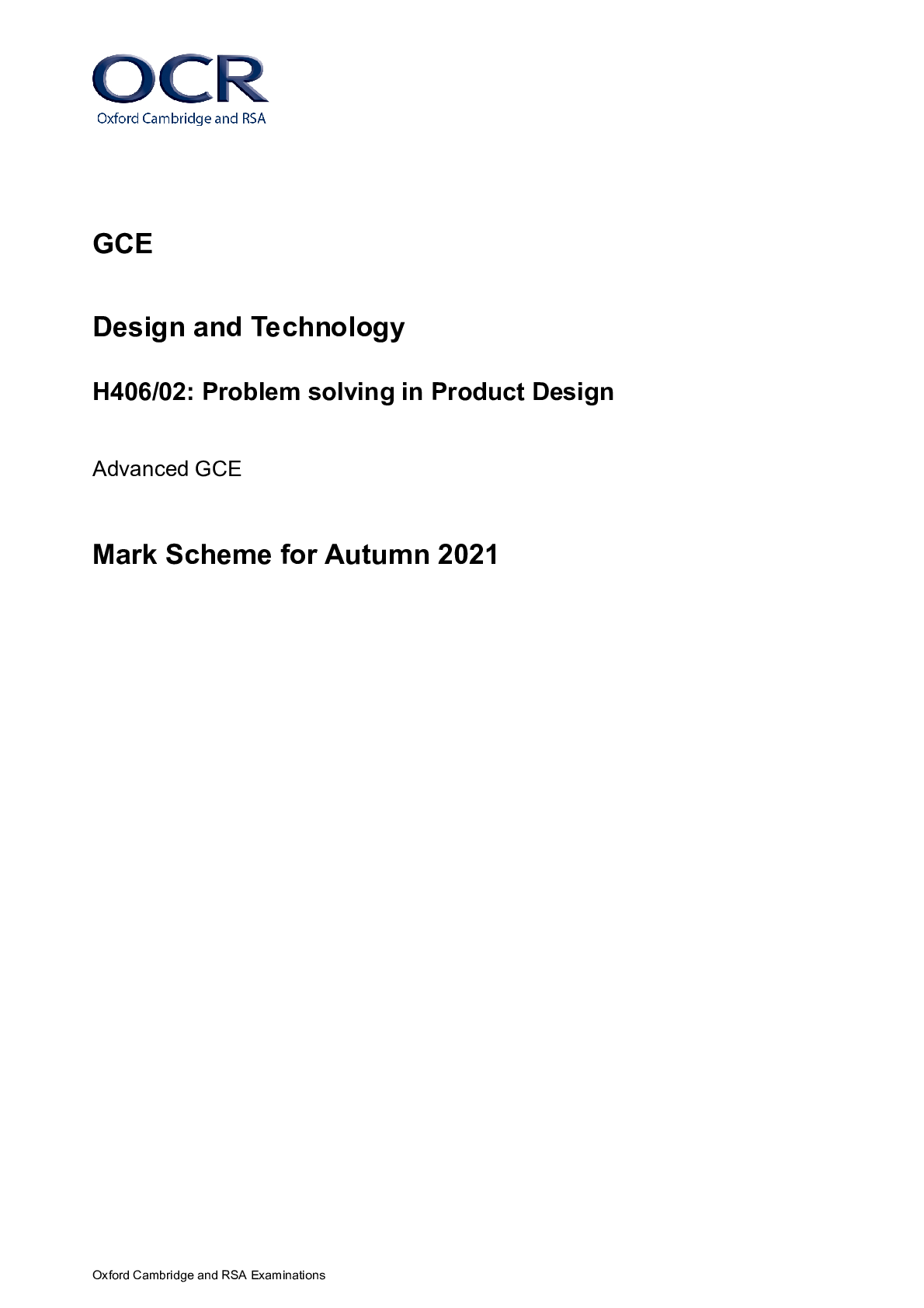
Reviews( 0 )
Document information
Connected school, study & course
About the document
Uploaded On
Oct 10, 2022
Number of pages
21
Written in
Additional information
This document has been written for:
Uploaded
Oct 10, 2022
Downloads
0
Views
124








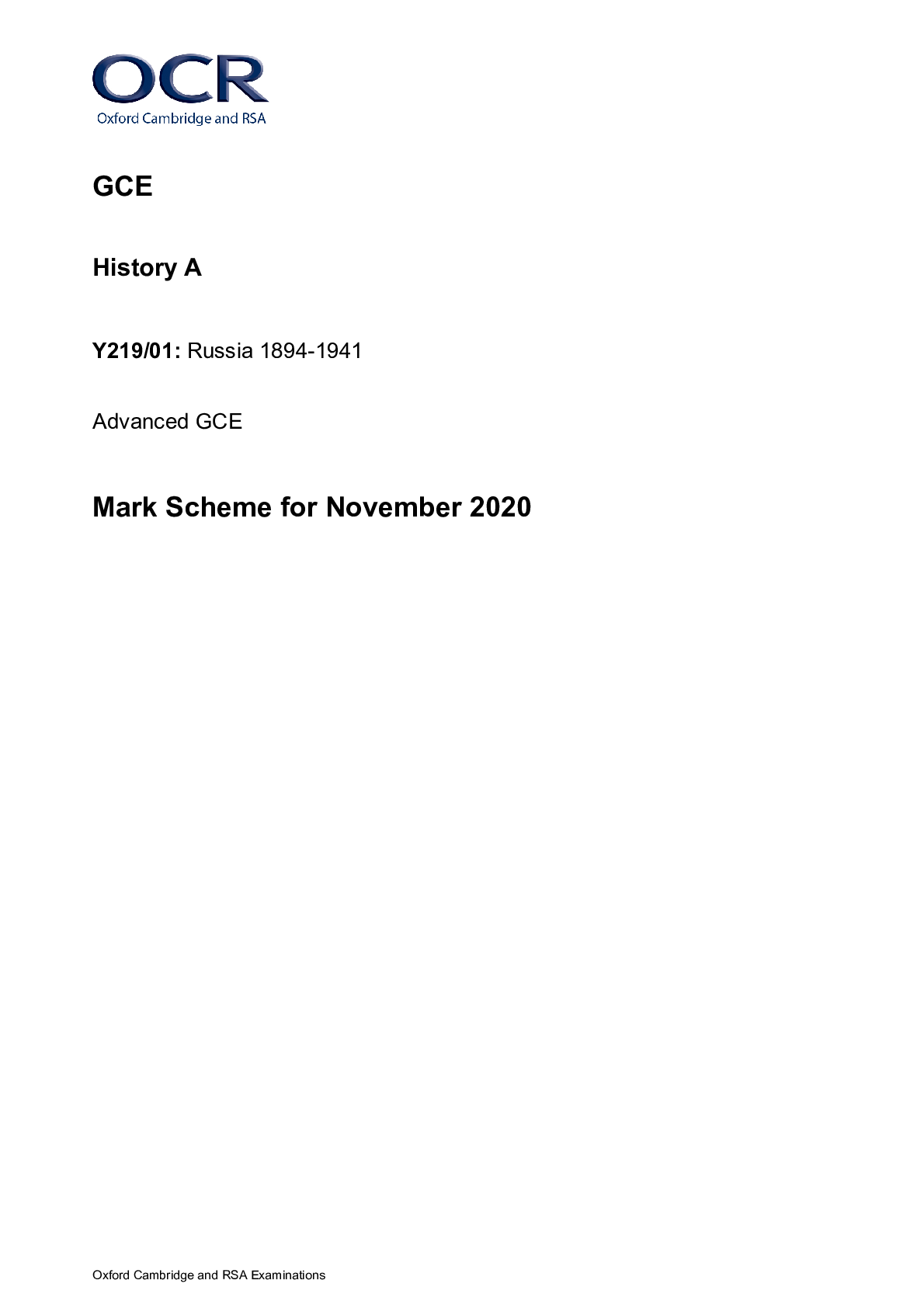
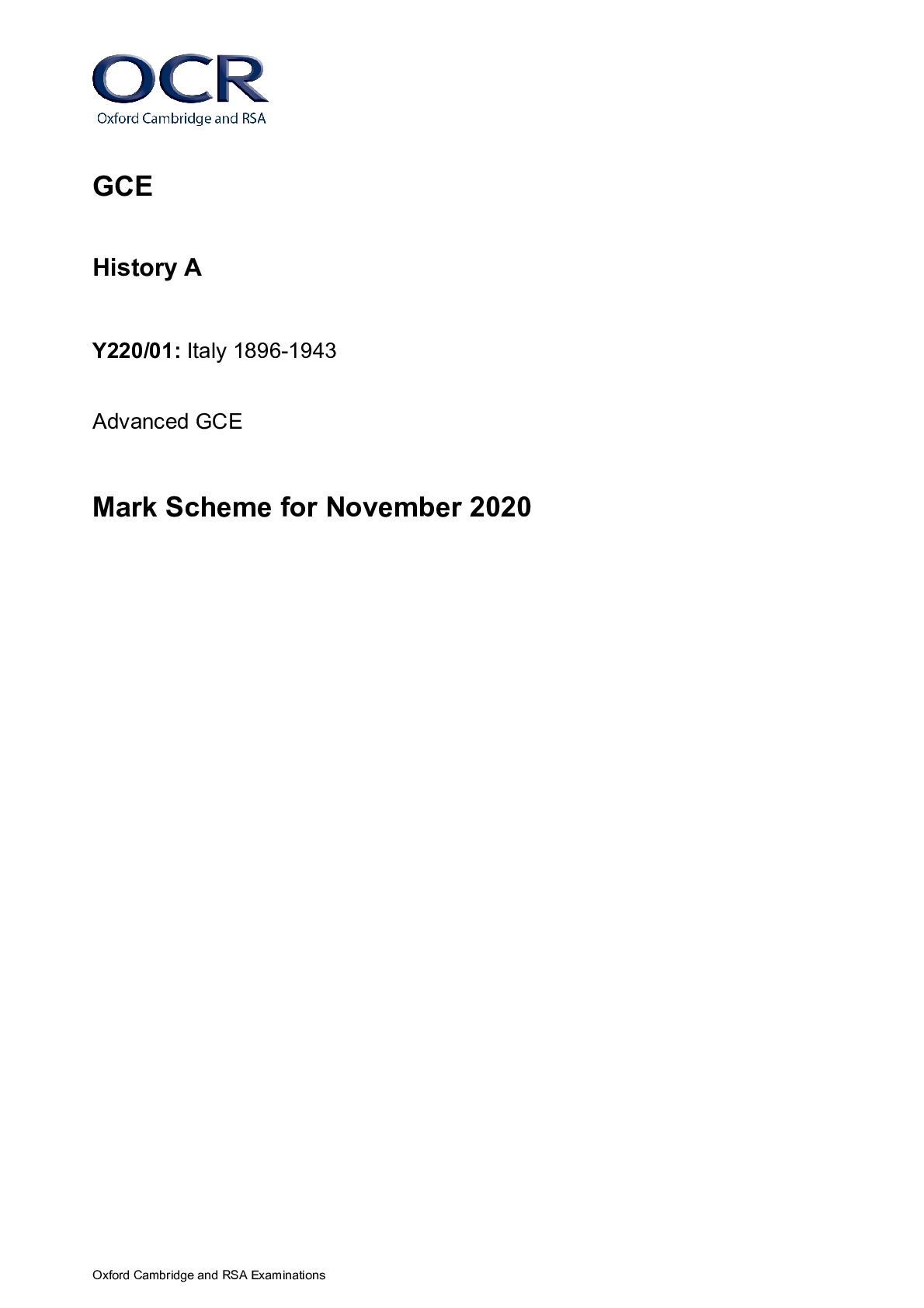

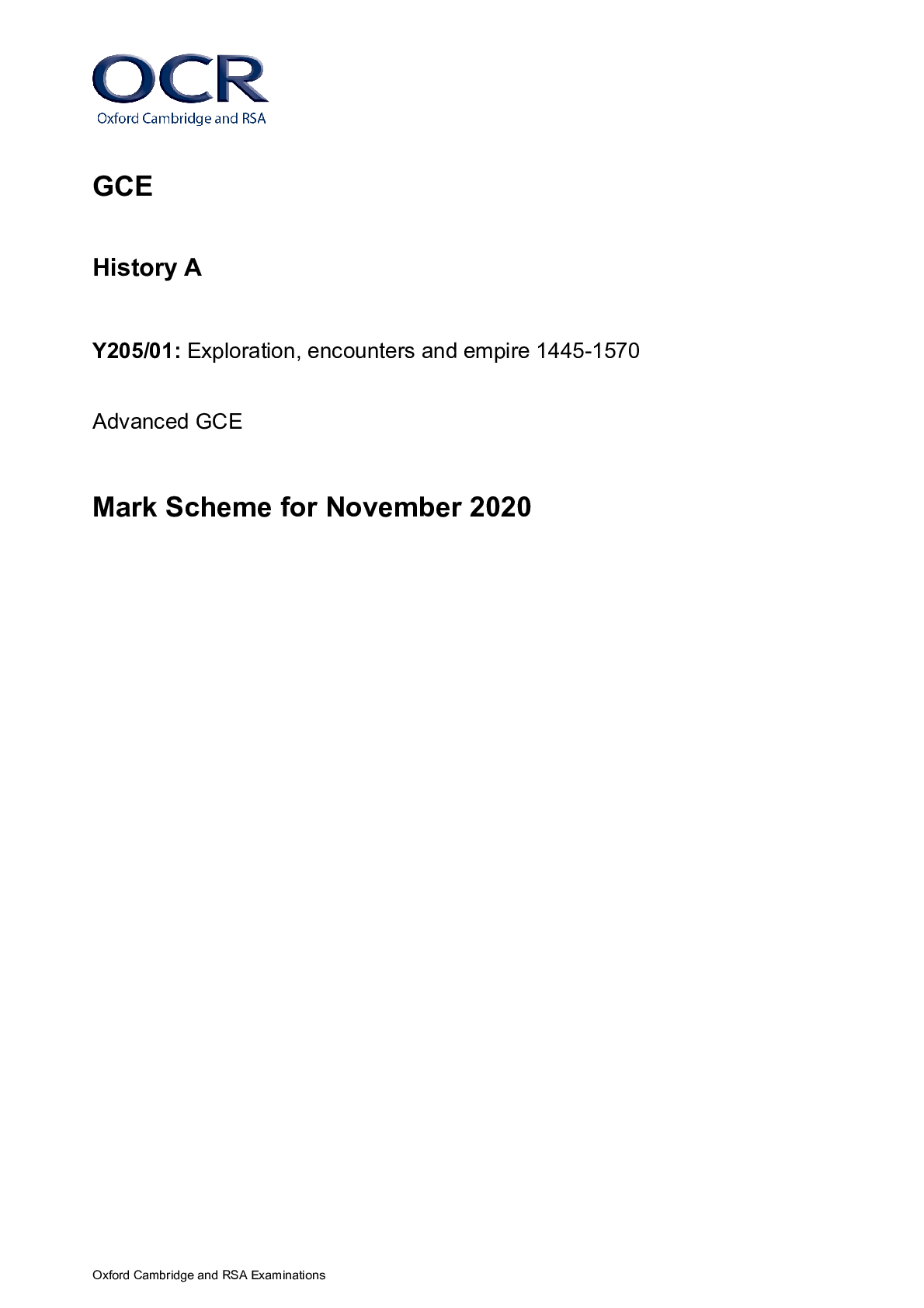
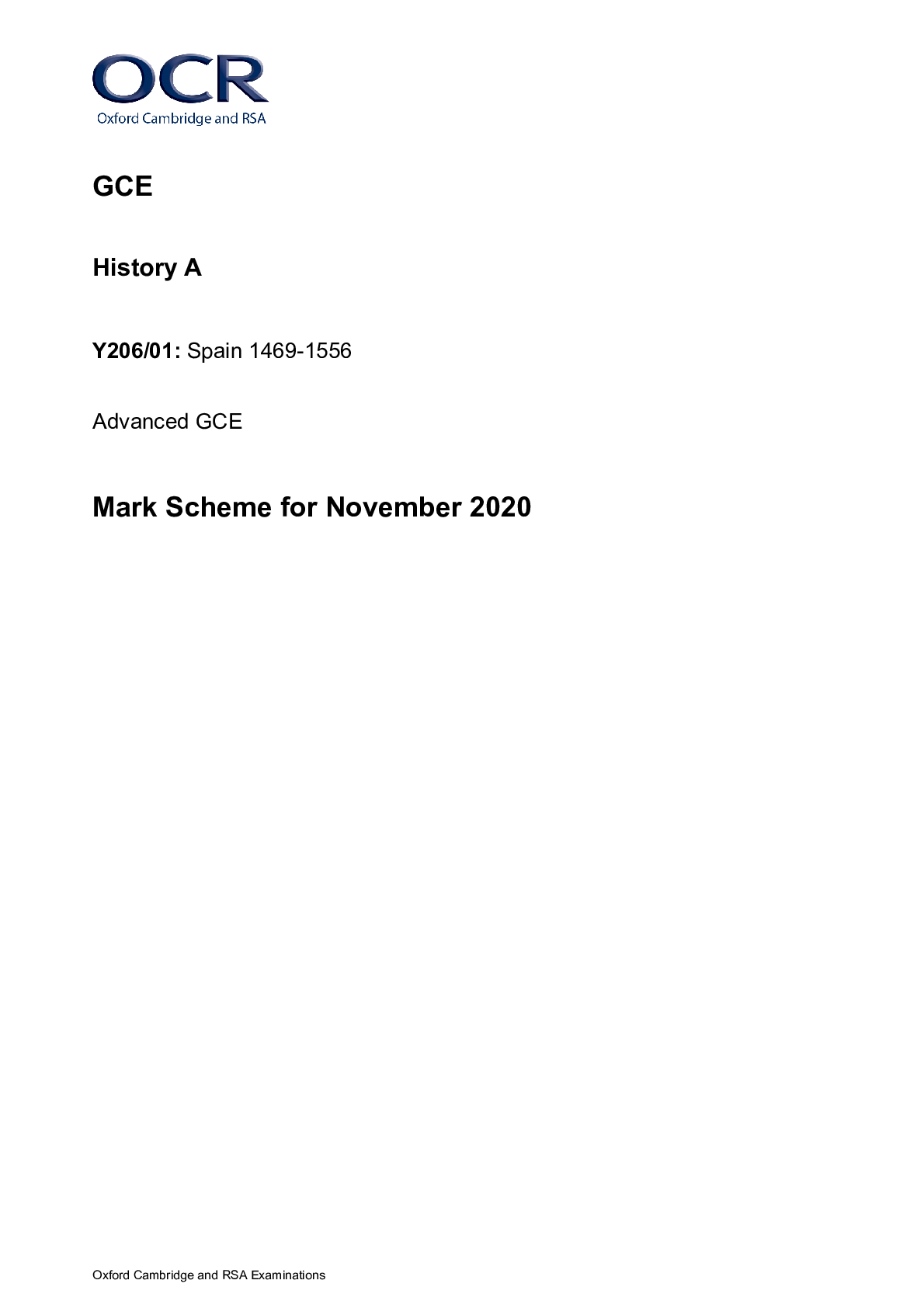
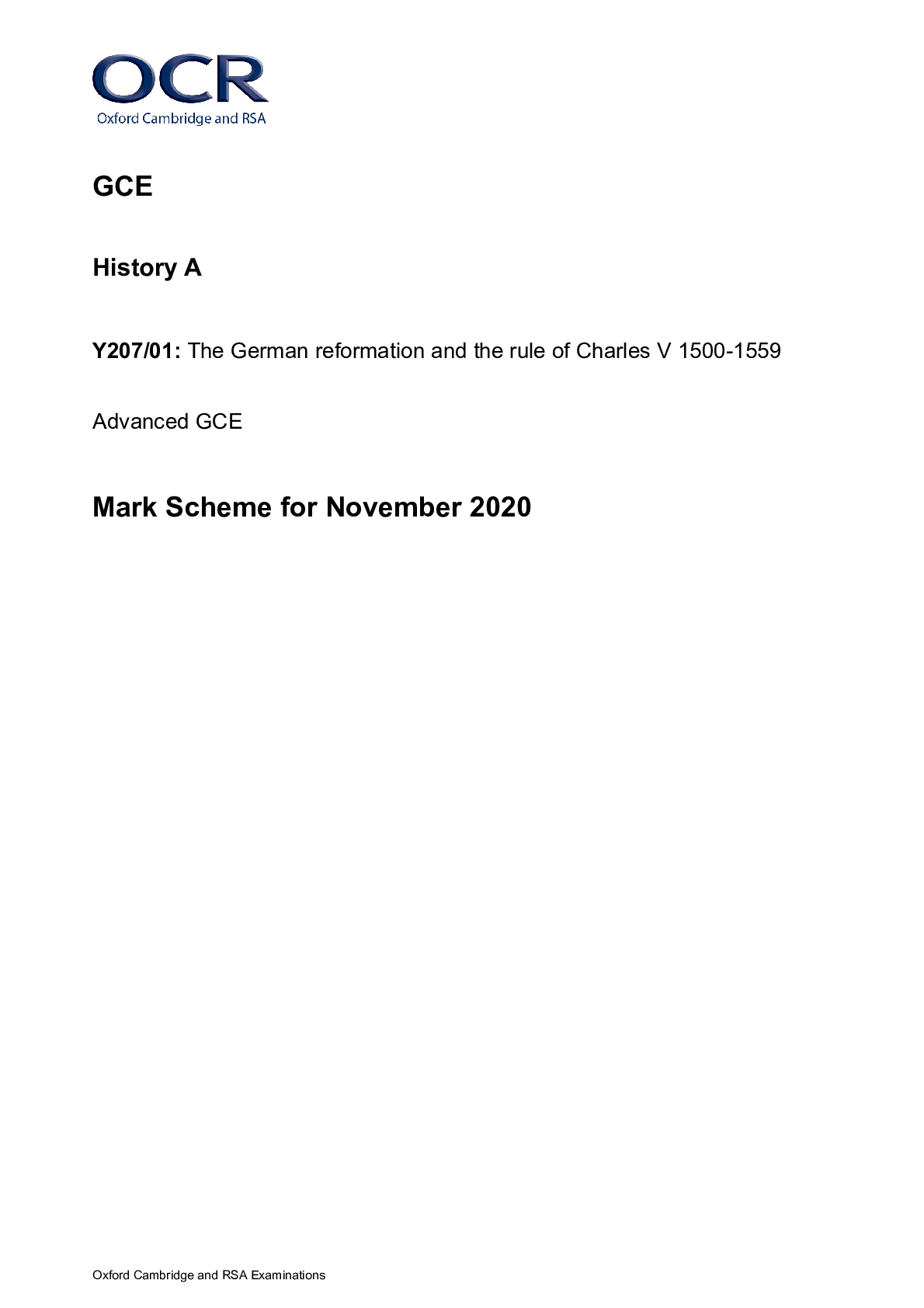
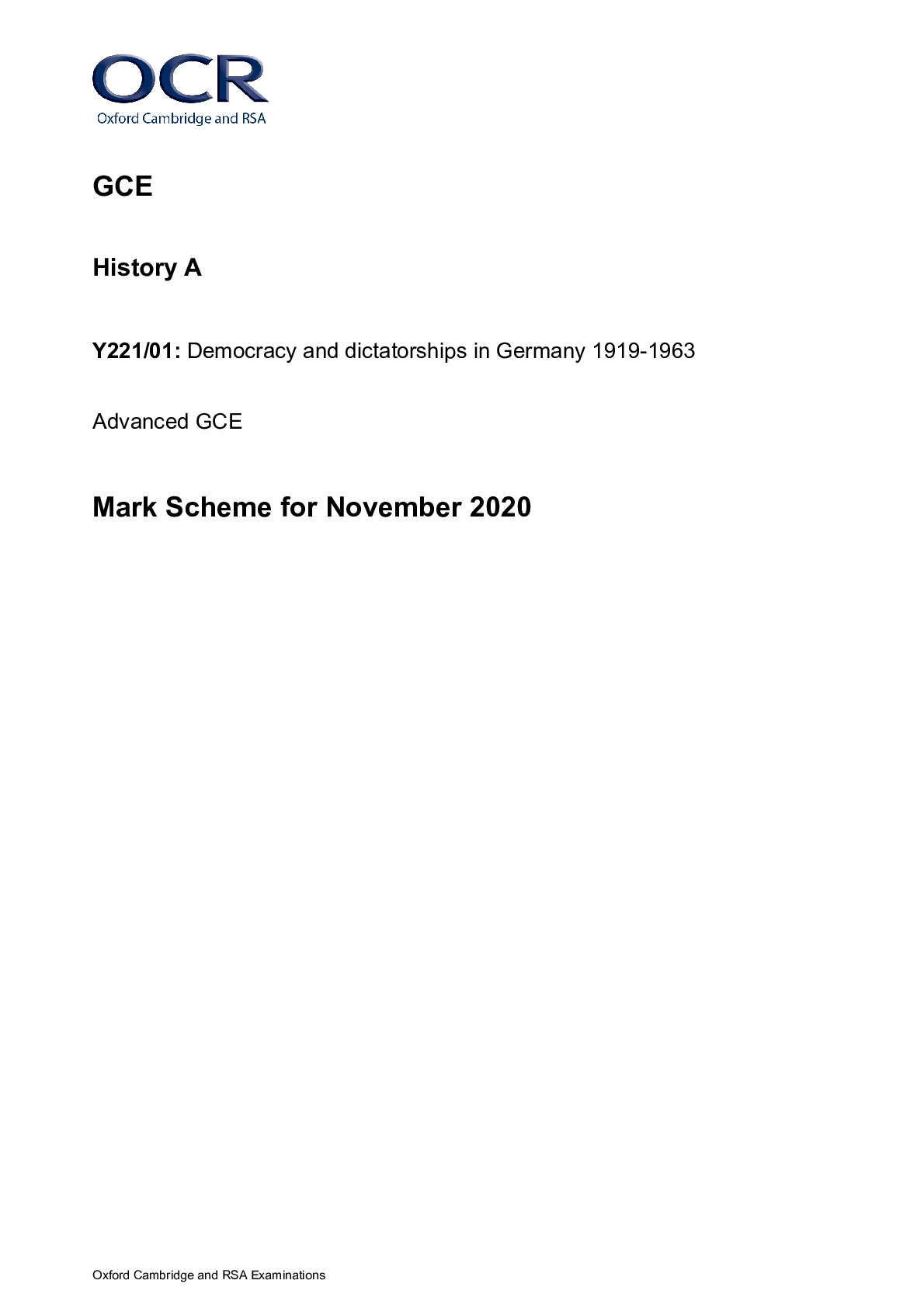

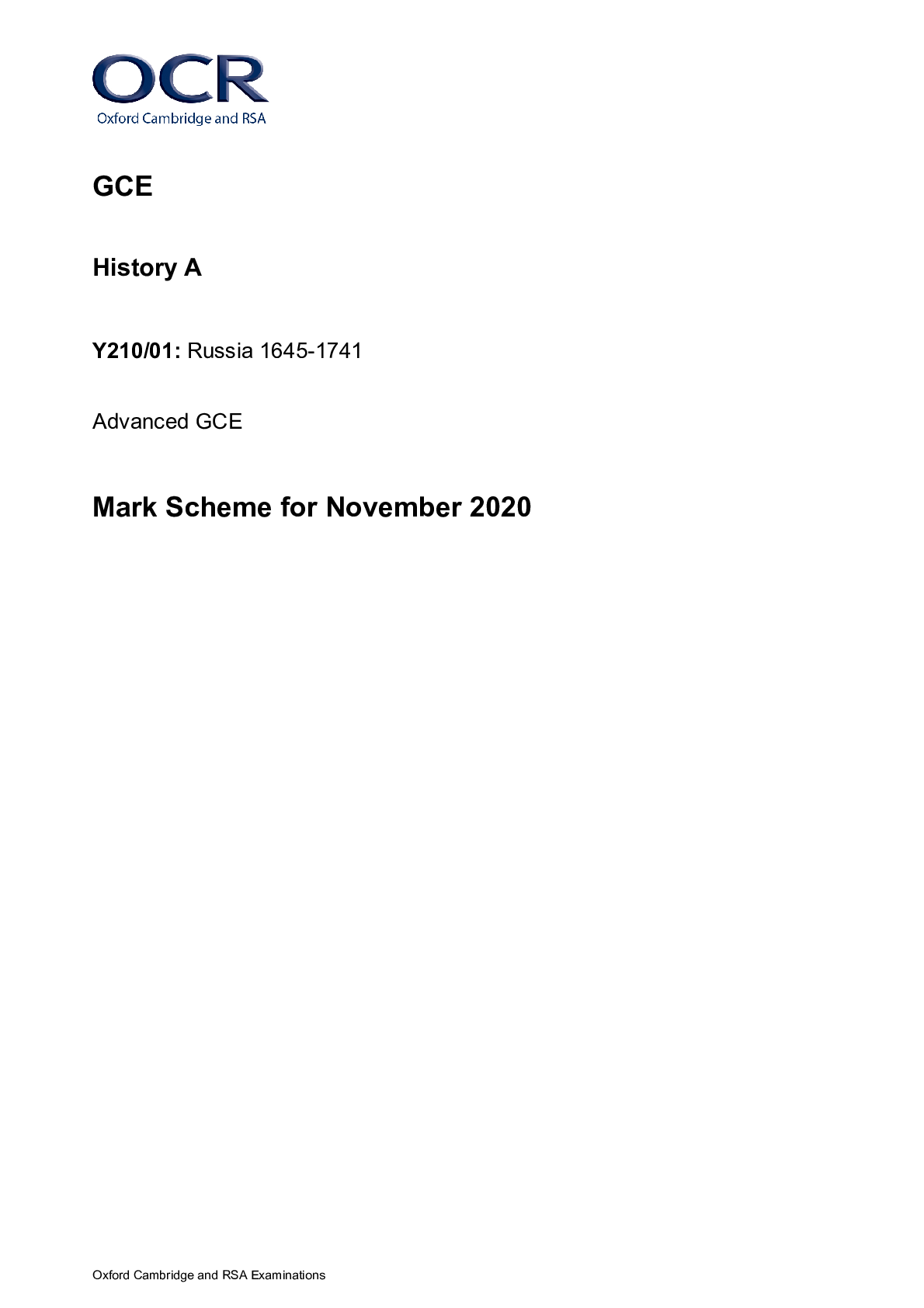


.png)






